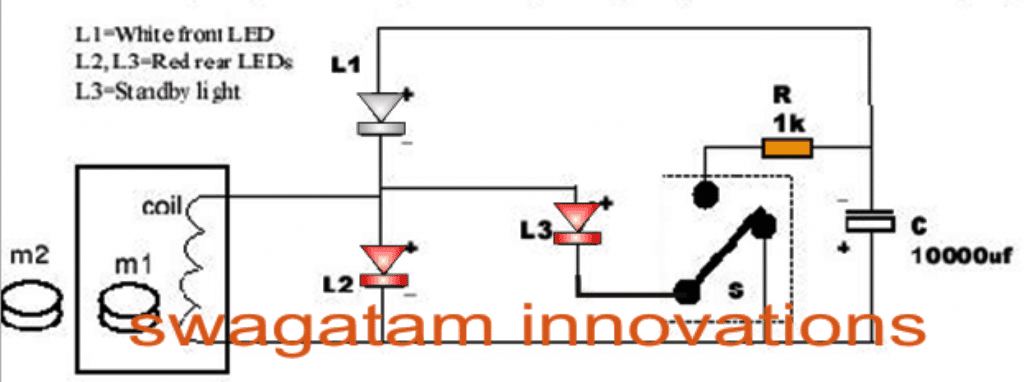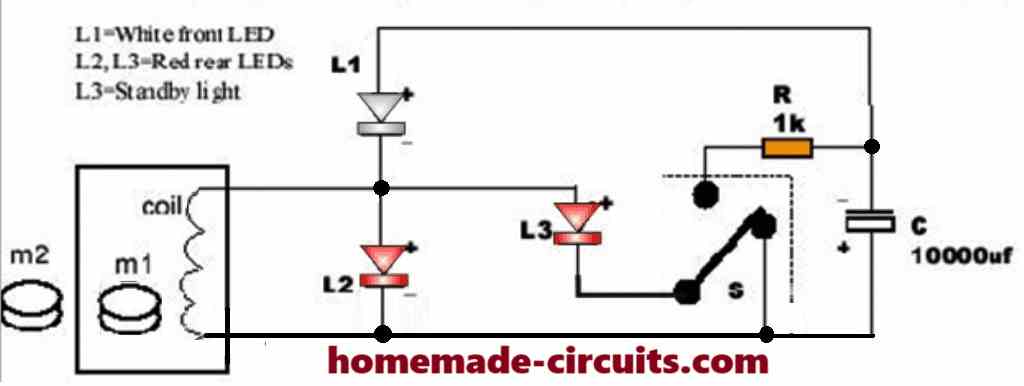In the following post I have explained a simple circuit idea which can be used for generating free electrical energy for illuminating a few safety flashing LEDs on a Bicycle.
The Circuit Concept
A bicycle like any other modern vehicle needs provision of lighting system for its use at night or cycling in lesser light. Usually a bicycle is designed with the front light and the back light, being red in colour. The front light is often fitted with a cycle using a dynamo system.
A dynamo generates alternating current by causing a friction in the tyre.
This actually slows down the speed and the cyclist has to paddle with more power to generate speed. Another kind of lighting can run through battery which is usually a detachable device.
But what if a situation when there is no need of dynamo, neither depending on battery for a bicycle light?
The introduction of an innovative system called ‘Safety Flashing Light’ has solved the purpose.
It not only helps to eradicate the concept of battery or dynamo system; it indeed offers more powerful light and longer standby compared to the other types.
This new electrical generating system has already created a sparkle in the bicycle market for its efficiency and ease-of-use.
How the Free Energy Bicycle Generator with Safety Flashing Light Works?
The Safety Flashing Light is designed in a way to handle all possible situations when driving a bicycle. For instance, a cycle when running in slower speed; two white-front LEDs and three red-rear LEDs flashes to make others notice on its presence.
In the case of standby mode, when the rear-wheel break is applied, the front and back LEDs gets activated. The lights are very bright and it can be noticed even in daylight.
Even no maintenance is needed, which made the operation hassle-free and easier to operate. The Safety Flash Light also works perfectly even on a rainy day.
This light system uses 8000-12000mcd LEDs for an optimum performance.
By: Dhrubajyoti Biswas
Circuit Diagram



Key Components and Their Functions
M1 (Tumbling Magnet)
- So we have got this freely tumbling magnet that is hanging out near a coil.
- It tumbles around because of the influence of M2 which is the magnet that is attached to the rotating bicycle wheel.
- This tumbling action is pretty cool because it induces an alternating current in the coil thanks to electromagnetic induction...yes, that’s Faraday's Law at work!
M2 (Magnet on Bicycle Wheel)
- Here we have a fixed magnet that is mounted right on the wheel.
- As the wheel spins M2 interacts with M1 making it tumble and generating electricity in the coil. It is like they are working together to create power!
Coil
- The coil is where the magic happens, it takes the mechanical motion of M1 and turns it into electrical energy.
- This generated electricity is what powers our lights and charges up the capacitor.
L1, L2, L3 (LEDs)
- L1 is our white front light and it is always on whenever the system is generating power.
- Then we have L2 and L3 which are our red rear lights. L3 even acts as a standby light providing some illumination when the bicycle is just hanging out and not moving.
C (10,000µF Capacitor)
- This capacitor is like a little energy storage unit that keeps all the juice generated by the coil.
- It makes sure that the rear lights especially L3 stay lit even when we are not pedaling.
R (1kΩ Resistor)
- The resistor plays a crucial role by controlling how fast the capacitor discharges its energy ensuring we get a steady current flowing to those LEDs.
S (Paddle Switch)
- This switch is connected to the rear brake system of our bicycle.
- When we hit the brakes this switch flips its position and directs stored energy from the capacitor to light up our standby light (L3).
Working Principle
Electricity Generation (While Riding)
- As we ride our bicycle the wheel starts to rotate and M2 makes M1 tumble around.
- That tumbling magnet (M1) generates a current in the coil through electromagnetic induction.
- This current then powers up our front LED (L1) and both of our rear LEDs (L2 and L3).
Charging the Capacitor
- Any extra electricity that gets generated by the coil goes on to charge up the capacitor (C).
- This means we’ are storing energy for when we decide to take a break and stop riding.
Operation When the Bicycle Stops
- If we pull on the brakes then that paddle switch (S) redirects all that stored energy in the capacitor through the resistor (R) to light up our standby LED (L3).
- This way we stay visible even when we' are just stationery and not moving.
Energy Discharge
- The capacitor slowly discharges its energy through the resistor which helps keep that standby light (L3) glowing for a little while after we stop riding.
Advantages
- Energy Utilization: We are harnessing the kinetic energy from riding our bike, a renewable source to generate electricity! How awesome is that?
- Safety: It makes sure our lights stay on (especially that rear standby light) when we stop which helps us be seen at night....safety first!
- Simple Design: There are no batteries or external power sources needed here so it is a super low-maintenance and eco-friendly!
Limitations
- The power output really depends on how fast we are going on our bike, if we are cruising slowly then those lights might not shine as bright.
- The capacitor has a limited storage capacity so that standby light wont stay on forever, it’ will only glow for a short time after we stop.
Basically this whole system is a clever way for us to power bicycle lights using mechanical energy without needing batteries at all... Its sustainable and super practical!
Hello Swagatam. And what LEDs are in this circuit?Does the magnet rotate inside the reel or outside in the common body, or near the end of the coil?If possible, then draw a more precise diagram, it can be improved in some way so that the LEDs glow brighter. I will be very grateful to you for everything.
Thank you Andrei,
M1 is the tumbling magnet inside the tube on which the coil is wound, and M2 is the magnet which is fixed on the rim of the cycle wheel.
When the wheel rotates the tumbling magnet tumbles inside the tube on which the coil is wound, while the M2 magnet lines cut the coil externally once on each rotation of the wheel.
Это я понял,но вы не ответили про светодиоды,какие там нужно ставить.
You can refer to this image which is clearer and shows the exact locations of the LEDs:
" rel="ugc">
Hello O Swagatam. My name is Andrei Gaponik, I am fond of soldering interesting schemes. I have a question for you: how is the free energy generator for a bicycle arranged in this scheme, how many turns of the generator coil or what resistance it has, how is the magnet located inside the generator body (at the end of the coil or along the coil).Thank you in advance.
Thank you Andrei,
I think you can experiment with a magnet/coil setup which can be identical to a shake powered flashlight, as explained in the following article:
https://www.homemade-circuits.com/shake-powered-flashlight-circuit/